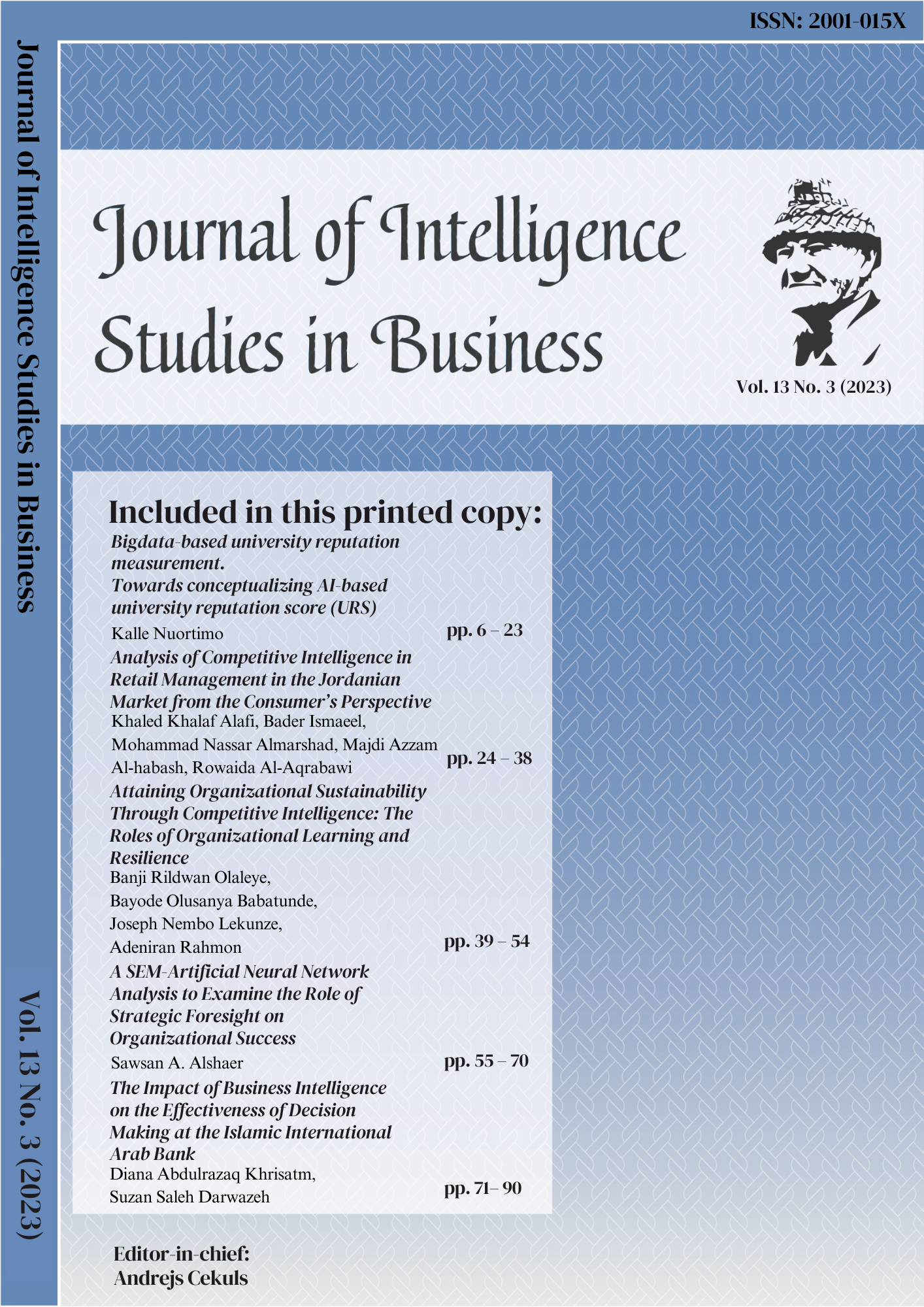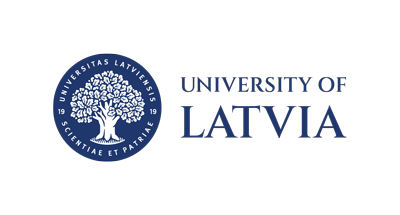Bigdata-based university reputation measurement. Towards conceptualizing AI-based university reputation score (URS)
Keywords:
automated university reputation measurement, opinion mining, generative AIAbstract
The competition inside higher education institutions, namely universities, is tightening, putting emphasize on competitive intelligence (CI) function. At the same time, communication has shifted to digital channels, this trend was largely influenced by Corona virus pandemic. This presents a challenge for university reputation measurement and ranking, while the electronic word to mouth (E-wom) is more challenging to measure, control or influence than the issues measured in traditional university rankings. While traditional metrics are based on measuring academic reputation via surveys and gathering data from research organisations, this paper presents a way to include AI, namely chatGPT and big-data based media-analytics with social media sentiment to aid analysing the reputation of a University. Results based on Finnish universities indicate, that differences between media visibility and sentiment exist, and can be to some extent utilized in rating universities in local level and also generalize to global level, finally targeting to URS (University reputation score) -index. Due to complexity of measuring the reputation of the university strictly via AI and automated opinion mining, several limitations exist. The context of Finnish universities were chosen in order to limit the scope of the analysis.
References
Ashforth, B. E., & Mael, F. (1989). Social identity theory and the organization. Academy of management review, 14(1), 20-39.
Astarkie, M. G., Bala, B., Bharat Kumar, G. J., Gangone, S., & Nagesh, Y. (2023, January). A Novel Approach for Sentiment Analysis and Opinion Mining on Social Media Tweets. In Proceedings of the International Conference on Cognitive and Intelligent Computing: ICCIC 2021, Volume 2 (pp. 143-151). Singapore: Springer Nature Singapore.
Bamberger, A., Bronshtein, Y., & Yemini, M. (2020). Marketing universities and targeting international students: a comparative analysis of social media data trails. Teaching in higher education, 25(4), 476-492.
Barnett , M . , Jermier , J . and Lafferty , B . ( 2006 ) Corporate reputation: The definitional landscape, Corporate Reputation Review , 9 (1) , 26 – 38 .
Borji, A. (2023). A categorical archive of ChatGPT failures. arXiv preprint arXiv:2302.03494.
Bouschery, S.G., Blazevic, V., & Piller, F.T. (2023). Augmenting human innovation teams with artificial intelligence: Exploring transformer-based language models. Journal of product innovation management, 40(2), 139-153.
Bromley , D . ( 2002 ) ‘ Comparing corporate reputations: League tables, quotients, benchmarks or case studies ’ , Corporate Reputation Review , 5 (1) , 33 – 50 .
Cascella, M., Montomoli, J., Bellini, V., & Bignami, E. (2023). Evaluating the Feasibility of ChatGPT in Healthcare: An Analysis of Multiple Clinical and Research Scenarios. Journal of Medical Systems, 47, 33.
Cearley, D., Burke, B., Searle, S., & Walker, M. J. (2016). Top 10 strategic technology trends for 2018. The Top, 10, 1-246.
ChatGPT limitations. https://amberstudent.com/blog/post/chatgpt-limitations-that-you-need-to-know. Accessed 27.8.2023
Dake, D. K., & Gyimah, E. (2023). Using sentiment analysis to evaluate qualitative students’ responses. Education and Information Technologies, 28(4), 4629-4647.
Durieux, V., & Gevenois, P. A. (2010). Bibliometric indicators: quality measurements of scientific publication. Radiology, 255(2), 342-351.
Escandon-Barbosa, D., Salas-Paramo, J., & Moreno-Gómez, J. (2023). Academic reputation quality and research: an analysis of Latin-American universities in the world higher education institution rankings from the perspective of organizational learning theory. Journal of Further and Higher Education, 1-15.
Farinloye, T., Wayne, T., Mogaji, E., & Watat, J. K. (2020). Social media for universities’ strategic communication. In Strategic marketing of higher education in Africa (pp. 96-115). Routledge.
Fitzgerald, H. E., Karen, B., Sonka, S. T., Furco, A., & Swanson, L. (2020). The centrality of engagement in higher education. In Building the Field of Higher Education Engagement (pp. 201-219). Routledge.
Foroudi, P., Yu, Q., Gupta, S., & Foroudi, M. M. (2019). Enhancing university brand image and reputation through customer value co-creation behaviour. Technological Forecasting and Social Change, 138, 218-227.
Floreddu, P. B., Cabiddu, F., & Evaristo, R. (2014). Inside your social media ring: How to optimize online corporate reputation. Business Horizons, 57(6), 737-745.
Freeman, R. E., Harrison, J. S., Wicks, A. C., Parmar, B. L., & De Colle, S. (2010). Stakeholder theory: The state of the art.
Garcia-Alsina, M., Cobarsi-Morales, J., & Ortoll, E. (2016). Competitive intelligence theoretical framework and practices: The case of Spanish universities. Aslib Journal of Information Management, 68(1), 57-75.
Giroux, H. (2002). Neoliberalism, corporate culture, and the promise of higher education: The university as a democratic public sphere. Harvard educational review, 72(4), 425-464.
Gupta, S., Urvashi, & Singh, A. (2023). A Vocabulary-Based Framework for Sentiment Analysis. In Computational Intelligence: Select Proceedings of InCITe 2022 (pp. 507-515). Singapore: Springer Nature Singapore.
Haleem, A., Javaid, M., & Singh, R.P. (2022). An era of ChatGPT as a significant futuristic support tool: A study on features, abilities, and challenges. BenchCouncil Transactions on Benchmarks, Standards and Evaluations, 2(4), 100089.
Haque, M.U., Dharmadasa, I., Sworna, Z.T., Rajapakse, R.N., & Ahmad, H. (2022). I think this is the most disruptive technology": Exploring Sentiments of ChatGPT Early Adopters using Twitter Data. arXiv preprint arXiv:2212.05856.
He, W., Zha, S., & Li, L. (2013). Social media competitive analysis and text mining: A case study in the pizza industry. International journal of information management, 33(3), 464-472.
Holtzhausen, D., & Zerfass, A. (2014). Strategic Communication: Opportunities and Challenges of the Research Area 1. The Routledge handbook of strategic communication, 3-17.
Jones, B., Temperley, J., & Lima, A. (2009). Corporate reputation in the era of Web 2.0: the case of Primark. Journal of marketing management, 25(9-10), 927-939.
Kocoń, J., Cichecki, I., Kaszyca, O., Kochanek, M., Szydło, D., Baran, J., Bielaniewicz, J., Gruza, M., Janz, A., Kanclerz, K., & Kocoń, A., (2023). ChatGPT: Jack of all trades, master of none. arXiv preprint arXiv:2302.10724.
Lafuente-Ruiz-de-Sabando, A., Zorrilla, P., & Forcada, J. (2018). A review of higher education image and reputation literature: Knowledge gaps and a research agenda. European research on management and business economics, 24(1), 8-16.
Liu, B. (2022). Sentiment analysis and opinion mining. Springer Nature.
Mbrain(2015). https://www.m-brain.com/. Information received 2015.
Mandelli, A., & Cantoni, L. (2010). Social media impact on corporate reputation: Proposing a new methodological approach. Cuadernos de información, (27), 60-74.
Mussard, M., & James, A. P. (2018). Engineering the global university rankings: gold standards, limitations and implications. IEEE Access, 6, 6765-6776.
Marshall, S. J., & Marshall, S. J. (2018). Internal and external stakeholders in higher education. Shaping the University of the Future: Using technology to catalyse change in university learning and teaching, 77-102.
Nuortimo, K., & Harkonen, J. (2019). Establishing an automated brand index based on opinion mining: analysis of printed and social media. Journal of Marketing Analytics, 7, 141-151.
Nuortimo, K. (2021). Hybrid approach in digital humanities research: a global comparative opinion mining media study (Doctoral dissertation, University of Oulu).
Ojala, P. 2018. ONKO SEN PAKKO OLLA MERSU?.Dissertaion, University of Turku, Marketing.
Olsson, E. K. (2014). Crisis communication in public organisations: Dimensions of crisis communication revisited. Journal of Contingencies and Crisis management, 22(2), 113-125.
OpenAI (2023). ChatGPT. https://chat.openai.com/chat. Accessed May 2023.
Panda, S., Pandey, S. C., Bennett, A., & Tian, X. (2019). University brand image as competitive advantage: a two-country study. International Journal of Educational Management.
Pham, H. T. (2018). Impacts of higher education quality accreditation: a case study in Vietnam. Quality in Higher Education, 24(2), 168-185.
Phillips, R. A. (Ed.). (2011). Stakeholder theory. Edward Elgar Publishing.
Rani, A., & Shivaprasad, H. N. (2021). Revisiting the antecedent of electronic word-of-mouth (eWOM) during COVID-19 Pandemic. Decision, 48(4), 419-432.
Rust, R. T., Rand, W., Huang, M. H., Stephen, A. T., Brooks, G., & Chabuk, T. (2021). Real-time brand reputation tracking using social media. Journal of Marketing, 85(4), 21-43.
Scott, G., & Wilson, D. (2002). Tracking and profiling successful IT graduates: An exploratory study.
Shehzadi, S., Nisar, Q. A., Hussain, M. S., Basheer, M. F., Hameed, W. U., & Chaudhry, N. I. (2020). The role of digital learning toward students' satisfaction and university brand image at educational institutes of Pakistan: a post-effect of COVID-19. Asian Education and Development Studies.
Sultan, P., & Wong, H. Y. (2019). How service quality affects university brand performance, university brand image and behavioural intention: The mediating effects of satisfaction and trust and moderating roles of gender and study mode. Journal of Brand Management, 26(3), 332-347.
T-Media, www.t-media.fi. Retrieved 27.8.2023
Thorp, H.H. (2023). ChatGPT is fun, but not an author. Science, 379(6630), 313-313.
Toklucu, E., Silman, F., Turan, S., Atasoy, R., & Kalkan, Ü. (2022). The effects of the crisis management skills and distance education practices of universities on student satisfaction and organizational image. Sustainability, 14(10), 5813.
Qin, C., Zhang, A., Zhang, Z., Chen, J., Yasunaga, M. & Yang, D. (2023). Is ChatGPT a general-purpose natural language processing task solver? arXiv preprint arXiv:2302.06476.
QS-index methodology(2021): https://www.topuniversities.com/qs-world-university-rankings/methodology. Retrieved xx.2021
QS rankings 2020. https://www.topuniversities.com/university-rankings-articles/world-university-rankings/out-now-qs-world-university-rankings-2020. Retrieved 27.7.2021
Yliopistolaki. https://www.finlex.fi/fi/laki/ajantasa/2009/20090558. Retrieved 27.7.2021.
van Dis, E.A.M., Bollen, J., Zuidema, W., van Rooij, R., & Bockting C. (2023). ChatGPT: five priorities for research. Nature, 614, 224-226.
Vidaver-Cohen, D. (2007). Reputation beyond the rankings: A conceptual framework for business school research. Corporate reputation review, 10, 278-304.
Volkwein, J. F. (2010). Assessing alumni outcomes. New Directions for Institutional Research, 2010(S1), 125-139.
Downloads
Published
Issue
Section
License
Copyright (c) 2024 Journal of Intelligence Studies in Business

This work is licensed under a Creative Commons Attribution-NonCommercial-NoDerivatives 4.0 International License.
Authors who publish with this journal agree to the following terms:
- Authors retain copyright and grant the journal right of first publication with the work simultaneously licensed under a Creative Commons Attribution License that allows others to share the work with an acknowledgement of the work's authorship and initial publication in this journal.
- Authors are able to enter into separate, additional contractual arrangements for the non-exclusive distribution of the journal's published version of the work (e.g., post it to an institutional repository or publish it in a book), with an acknowledgement of its initial publication in this journal.
- Authors are permitted and encouraged to post their work online (e.g., in institutional repositories or on their website) prior to and during the submission process, as it can lead to productive exchanges, as well as earlier and greater citation of published work (See The Effect of Open Access).








